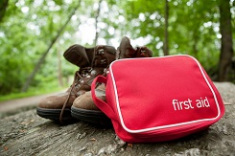Hiking is a great way to get in some exercise, enjoy the beauty of the great outdoors and get some fresh air. It also helps kids to learn about the environment and life sciences while getting them off of the couch and away from the electronic devices that so many kids are attached to. Like most activities, however, it’s not without its share of risks. In order to ensure that everyone on your hiking trip returns in good shape, these are 10 of the first aid facts relevant to hiking that each member of your party should know.
How to Pack a First Aid Kit
Even if you’re planning to purchase a pre-made first aid kit for your journey, it’s important that at least two members of your party know how and when to use each item within it. Pre-packaged kits also tend to be less specific to appeal to a larger purchasing audience, so they may not include all of the things you’ll need to ensure that you’re capable of treating common hiking injuries.
How to Treat a Snake Bite
The majority of snakes in the United States are not poisonous, and your chances of running across even a non-venomous snake are relatively rare. That being said, snakebites are still a common enough occurrence to warrant a working knowledge of their treatment. The tricks you see in movies are actually more dangerous than helpful, so don’t attempt to suck any venom out of a snakebite with your mouth.
How to Spot the Signs of Lyme Disease
Ticks are an unfortunate reality when it comes to hiking, even if you’re swathed in a mist of toxic insect repellents. Fortunately, tick-borne diseases are relatively rare and can often be avoided altogether if their earliest signs are spotted quickly enough. Should you or your child be bitten by a tick, be careful not to introduce bacteria into the open wound and keep watch over the site for a red, circular rash around the bite that resembles a target.
How to Properly Apply Bandages
When the primary goal of a bandage is to stop bleeding and cover an open wound until it can be treated properly in a more sterile environment, most people don’t stop to think about how one should be properly applied. Be sure, for instance, that you’re not spreading the adhesive over the open area of a wound and that you’re using the right bandage for the job.
How to Spot an Allergic Reaction
Bee and wasp stings are painful for anyone, but they can be downright deadly to those with allergies to the venom of these insects. Before heading out into the great wide open, be sure that you know how to spot the signs of anaphylaxis and that you’re prepared to treat them until emergency medical assistance arrives.
How to Treat a Blister
While certainly not a life-threatening injury, blisters and raw spots from new or ill-fitting boots can still be a major pain. Having moleskin or other suitable materials on hand to protect tender skin from further irritation is essential, as is knowing how to apply them in order to ensure full coverage.
How to Recognise Signs of Dehydration
Hiking is thirsty work, so be sure that you’ve packed more than enough water to see you through the end of your journey. Should you run out of water, or should an overly excited child neglect to drink as much as he should, it’s also essential that you know how to diagnose and properly treat dehydration on the trail.
How to Stay Warm When Temperatures Plummet
More often than not, you’ll have a basic idea of the weather conditions or at least the temperature in the area where you’re hiking. Sometimes, though, temperatures unexpectedly plummet or you’re left outdoors later into the evening than you expect. Knowing how to stay warm in truly cold temperatures is imperative.
How to Treat Burns
If your hiking trip will include the building of a campfire, use of a lantern or even just prolonged exposure to the sun without proper protection, you’ll need to know how to treat any burns that could be inflicted upon someone in your hiking party.
How to Prevent Common Injuries
Better than knowing how to treat common hiking injuries, which is essential, is knowing how to prevent them in the first place. Make sure that everyone has more than enough water, that sunscreen has been liberally applied, that shoes and clothing are properly fitted and that the trail you’re blazing isn’t too advanced for the skill level of the most inexperienced hiker in the group.

